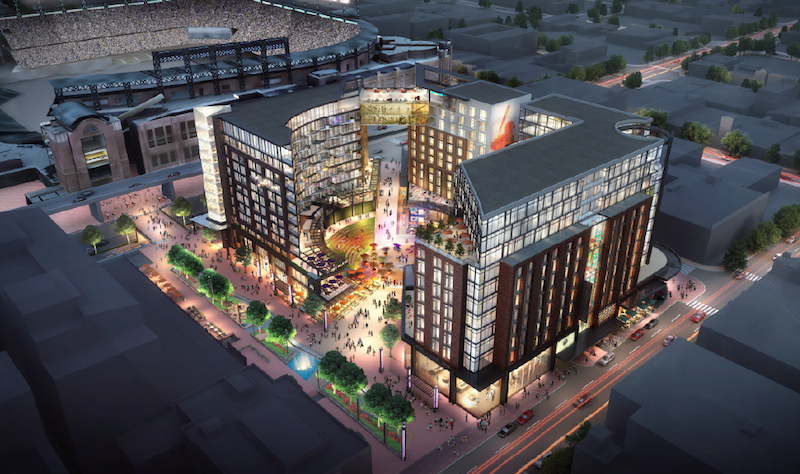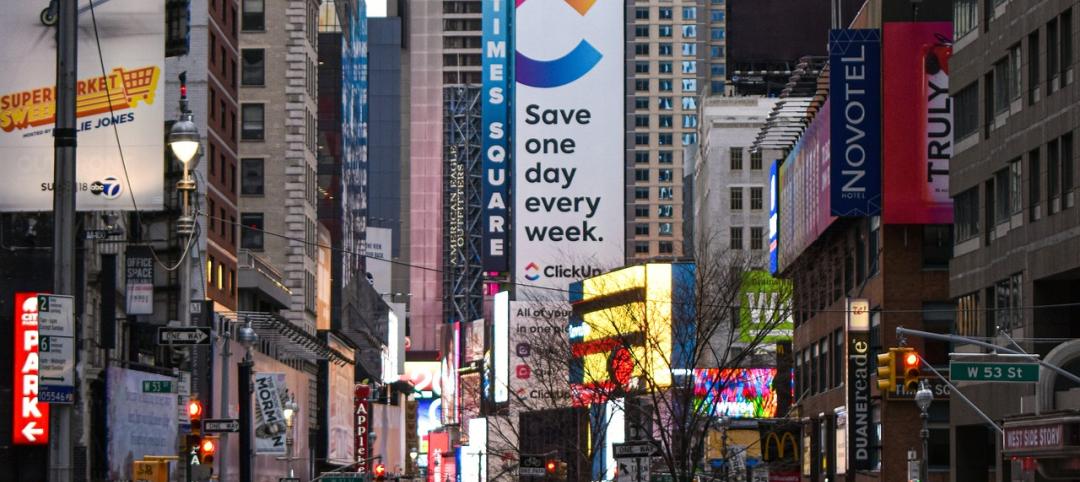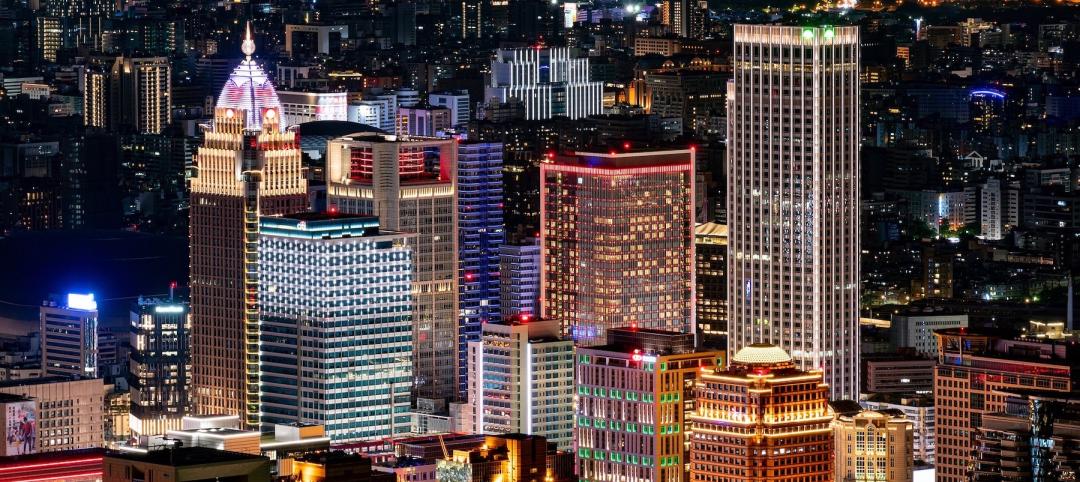Sports arenas and stadiums continue to be the stimuli for urban reincarnations.
Stantec has several sports “district” projects underway in Dallas, Tampa, Chicago, and Edmonton. In Denver, the firm is proposing to transform a parking lot near Coors Field, home to the Colorado Rockies baseball team, into a mixed-used environment across an entire city block. Offices would account for half of the total square footage, which would include spaces for hospitality, residential, retail, entertainment, and food and beverage.
The proposal for this three-acre project, which is entering its entitlements phase and should start construction next year, would include a new Colorado Rockies Hall of Fame facility and an outdoor “content plaza,” which beyond serving as a pre- and post-game gathering place for fans, would function year-round as a space for concerts, festivals, and other activities, complete with restaurants and A/V systems.
The Building Team includes architect RNL (part of Stantec) and Hensel Phelps (GC). The baseball team is the developer and the Stadium District owns the land, which is the last open parcel connected to Denver’s LoDo district, Union Station, and RiNo district.
As part of the major Wrigleyville investment around Wrigley Field in Chicago, Stantec designed new exteriors for the field, and is lead designer for the new boutique Hotel Zachary.
In Minneapolis, the general contractor Ryan Companies played a central role in transforming a ramshackle downtown area that was mostly parking lots into office and residential space located near the 70,000-seat U.S. Bank Stadium, which opened in 2016 and, on February 4, will host Super Bowl LII.
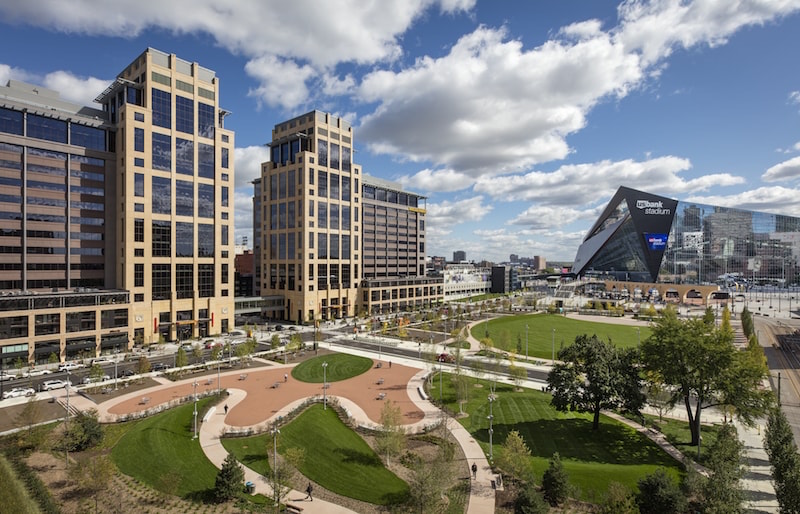 The city of Minneapolis has converted five barren blocks near U.S. Bank Stadium into a vibrant destination that includes two parks, office and residential buildings, and restaurants and retail. Image: Paul Crosby/Courtesy of Ryan Companies
The city of Minneapolis has converted five barren blocks near U.S. Bank Stadium into a vibrant destination that includes two parks, office and residential buildings, and restaurants and retail. Image: Paul Crosby/Courtesy of Ryan Companies
This project dates back to 2012, when the Minnesota Legislature approved funding for a new stadium for the Minnesota Vikings professional football franchise. The site chosen for that stadium was the former site of the Hubert H. Humphrey Metrodome, where the Vikings played from 1982 until it closed in 2013.
That site is adjacent to five city blocks that the Minneapolis Star-Tribune owned at the time. On these parcels, the newspaper’s headquarters and printing facilities were surrounded by surface parking and not much else.
In an effort to significantly upgrade this area, Mayor R.T. Rybak brought together the Tribune, Wells Fargo, and Ryan Companies to devise a redevelopment plan.
What they came up with now includes a 1.28-million-sf, $300 million, two-building complex into which Wells Fargo in 2016 moved 5,000 employees who previously had been working in nine different buildings in the downtown area. The towers represent the third-largest LEED Platinum-certified complex in the world, and the largest in the U.S.
The Downtown East Project, as it is known, added 4.2 acres of parkland over two blocks known as Downtown East Commons (Hargreaves Associates was the landscape architect), a 1,160-slot parking garage, a 164-key Radisson Red hotel, 31,000 sf of retail space, another multi-tenant office building, and the 195-unit Edition Apartments, 120 units of which face the park and street (The Tribune moved its printing to the suburbs, and downsized its headquarters in 2015 to a nearby office complex.)
The redeveloped area is along city’s light-rail system, and connects to Minneapolis’ indoor skyway that spans this metro.
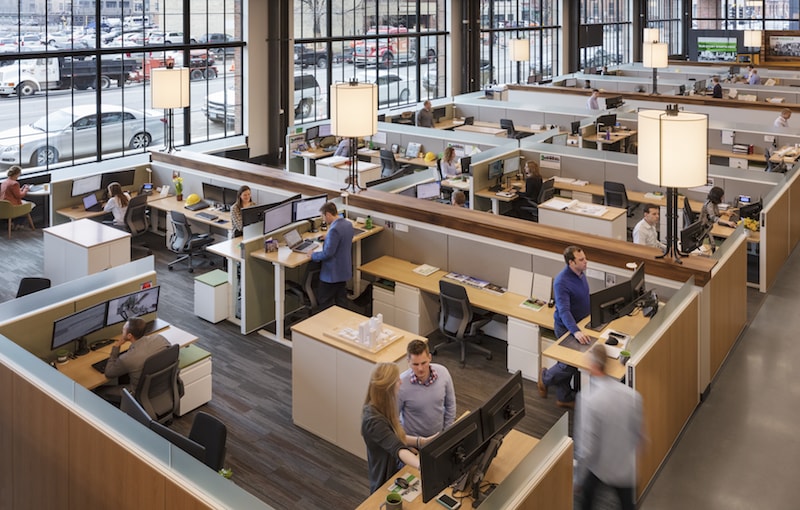
Ryan Companies, the general contractor on the Downtown East project in Minneapolis, is leasing the first two floors of the Millwright Building within that redevelopment for 300 of its employees. Image: Paul Crosby/Courtesy of Ryan Companies
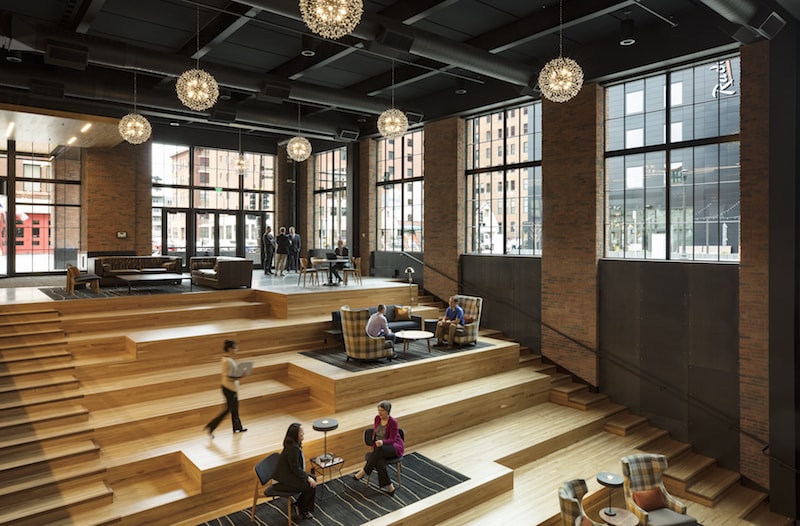
A sunken wooden lobby is an amenity for Ryan Companies' employees and a space-saving solution for the Millwright Building. Image: Paul Crosby/Courtesy of Ryan Companies
Last April, Ryan Companies moved 300 of its 1,200 employees into the new 190,000-sf Millwright building, another piece of the Downtown East Project. The company currently uses 65,000 sf within the first two floors. It is leasing the third and fourth floors for the Super Bowl. Ryan also owns the air rights over the parking garage, which can support a 20-story building, according to Josh Ekstrand, AIA, NCARB, Ryan’s Director of Design.
Ryan Companies US was the general contractor for the entire project. A wholly owned subsidiary, Ryan Architecture + Engineering (A+E), was the design architect for the exterior and AOR for the core and shell of the Wells Fargo towers. RSP designed the towers’ interior core spaces, and Perkins + Will was the interior architect for the towers’ office floors.
Ryan A+E was designer and AOR for the Edition apartments, whose interiors were designed by ESG. Ryan A+E also was design architect, AOR, and interior and core-and-shell design for its offices in Millwright.
Ryan A+E was design architect on the parking garage (RSP was AOR), and design architect and AOR on the Skyways. ESG was design architect and AOR on Radisson Red.
The city of Minneapolis, which paid for the project with $62 million in bond financing, estimates that Downtown East will generate $14.1 million in new property taxes in 2018, of which $3.2 million will accrue to the city.
Related Stories
Urban Planning | Apr 12, 2024
Popular Denver e-bike voucher program aids carbon reduction goals
Denver’s e-bike voucher program that helps citizens pay for e-bikes, a component of the city’s carbon reduction plan, has proven extremely popular with residents. Earlier this year, Denver’s effort to get residents to swap some motor vehicle trips for bike trips ran out of vouchers in less than 10 minutes after the program opened to online applications.
Urban Planning | Apr 12, 2024
New York City’s safest year for pedestrians due to concerted effort of street redesign, speed restrictions
In 2023, New York City recorded its safest year for pedestrians since record-keeping began in 1910. In a city of 8.5 million people, 101 deaths were due to vehicles striking pedestrians, less than one-third the number of the early 1990s. New York City ramped up its efforts to make walking and biking safer in 2014 when the city reduced its speed limit to 25 miles per hour.
Codes and Standards | Apr 8, 2024
Boston’s plans to hold back rising seawater stall amid real estate slowdown
Boston has placed significant aspects of its plan to protect the city from rising sea levels on the actions of private developers. Amid a post-Covid commercial development slump, though, efforts to build protective infrastructure have stalled.
Mixed-Use | Apr 4, 2024
Sustainable mixed-use districts: Crafting urban communities
As a part of the revitalization of a Seattle neighborhood, Graphite Design Group designed a sustainable mixed-use community that exemplifies resource conversation, transportation synergies, and long-term flexibility.
Codes and Standards | Mar 18, 2024
New urban stormwater policies treat rainwater as a resource
U.S. cities are revamping how they handle stormwater to reduce flooding and capture rainfall and recharge aquifers. New policies reflect a change in mindset from treating stormwater as a nuisance to be quickly diverted away to capturing it as a resource.
Urban Planning | Mar 17, 2024
A new report surveys city dwellers about urban living
Architects are rethinking the city of the future in terms of relieving resident challenges.
MFPRO+ Special Reports | Feb 22, 2024
Crystal Lagoons: A deep dive into real estate's most extreme guest amenity
These year-round, manmade, crystal clear blue lagoons offer a groundbreaking technology with immense potential to redefine the concept of water amenities. However, navigating regulatory challenges and ensuring long-term sustainability are crucial to success with Crystal Lagoons.
Urban Planning | Feb 5, 2024
Lessons learned from 70 years of building cities
As Sasaki looks back on 70 years of practice, we’re also looking to the future of cities. While we can’t predict what will be, we do know the needs of cities are as diverse as their scale, climate, economy, governance, and culture.
Healthcare Facilities | Jan 7, 2024
Two new projects could be economic catalysts for a central New Jersey city
A Cancer Center and Innovation district are under construction and expected to start opening in 2025 in New Brunswick.
Sustainability | Jan 2, 2024
Los Angeles has plan to improve stormwater capture and source 80% of water locally
Los Angeles County’s Board of Supervisors voted for a plan to improve stormwater capture with a goal of capturing it for local reuse. The plan aims to increase the local water supply by 580,000 acre-feet per year by 2045.


